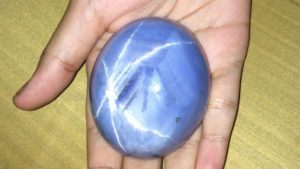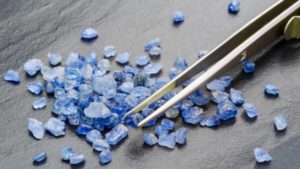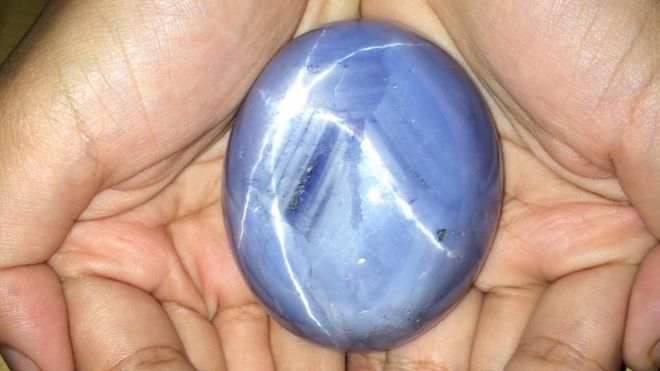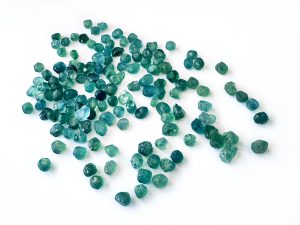Gemologists in Sri Lanka claim that the largest blue star sapphire yet has been discovered in a mine in the country.
The gemology institute in the capital Colombo has certified that the gem weighs 1404.49 carats and say they have not certified anything larger.
The gem is valued at at least $100m and the current owner estimates that it could sell for up to $175m at auction.
Sri Lanka’s gem industry, for which sapphire is the main export, is worth at least £70m ($103m) annually.
Blue star sapphires are so named because of the distinctive mark found at their centre.
“The moment I saw it, I decided to buy,” the current owner, who wishes to remain anonymous, told the BBC World Service’s Newsday programme.
“When the stone was brought to me I suspected that it might be the world’s largest blue star sapphire. So I took a risk and bought it.”
The owner said it was “absolutely confidential” how much he paid for it. The previous record holder weighed 1,395 carats.
The new gem was mined in the city of Ratnapura, in southern Sri Lanka, which is known as the City of Gems.
 The engagement ring belonging to the Duchess of Cambridge, and Diana, Princess of Wales before her, is believed to include a Sri Lankan sapphire (AP)
The engagement ring belonging to the Duchess of Cambridge, and Diana, Princess of Wales before her, is believed to include a Sri Lankan sapphire (AP)
It has been named the The Star of Adam by its current owner, after a Muslim belief that Adam arrived in Sri Lanka after being sent away from the Garden of Eden. It is claimed he then lived on the slopes of a mountain now known as Adam’s Peak.
The owner of the Star of Adam said he bought it thinking “this was not a piece of jewellery but an exhibition piece”.
Speaking to the BBC, Armil Samoon, a leading gem and jewellery dealer in Sri Lanka, confirmed this was the largest blue star sapphire in the world.
A 17kg (2st 9lb) rock containing sapphires was revealed in 2013, but the final weight of the gems inside is not yet known.
Sri Lanka’s Gem and Jewellery Association said in 2011 that the engagement ring for Catherine Middleton, the Duchess of Cambridge, included a sapphire mined in the country in the 1970s.
It was previously owned by Diana, Princess of Wales.
The world’s biggest blue sapphire has attracted a lot of attention, but how did it get to be so huge?
By Melissa Hogenboom
The world’s largest ever blue sapphire has been unveiled, discovered in Sri Lanka’s Ratnapura mines.
It weighs an astonishing 1404.49 carats, equivalent to about 280g (just under 10 ounces). Local gemologists say they have never seen a larger sapphire.
It is a type of gem known as a “star sapphire”, due to the six-pointed star within the gem. This occurs because of the way light reflects from crystals trapped within it.
Its anonymous owner spoke to the BBC and suggests it could sell for up to $175m.
BBC Earth spoke to mineral scientist Simon Redfern from the University of Cambridge in the UK, to find out how such enormous gems can form.
 Large sapphires like this are extremely rare
Large sapphires like this are extremely rare
Making sapphires is a lengthy process. This particular sapphire would have formed within the rocks of Sri Lanka’s highlands.
The rocks are mostly granites, which form when molten magma cools and solidifies. But they have been subjected to intense heat and pressure.
“The granites have been dated as almost two billion years old, and were subsequently squeezed and re-worked in a massive metamorphic mountain-building episode that happened more than 500 million years ago,” says Redfern. “Temperatures and pressures deep within the roots of these mountains would have reached more than 900C and over 9000 atmospheres pressure.”
The sapphire could have formed within the granite itself before it was re-worked, or later when the rocks were being heated and squeezed.
“In either case, the temperatures and pressures would have changed only very slowly over millions and millions of years,” says Redfern. “This is how the crystal was able to grow so big.”

Smaller sapphires, like these uncut ones, are prevalent in Sri Lanka (Credit: Ingemar Magnusson/Alamy)
After the gem formed, it sat within the rocks while they were uplifted into mountains, which were then eroded. “And so it was brought to the surface, picked out of the rock by the forces of rain and weathering, and transported down river to the gem sands of Ratnapura,” says Redfern.
Minerals such as sapphire can only survive journeys like this because they are so hard. Other, softer rocks would have eroded into mud and sand, helped along Sri Lanka’s river beds by the country’s heavy rainfall.
Sapphires are so hard because they are formed from corundum, an aluminium oxide. “Corundum is the hard gritty stuff used as an abrasive in emery paper,” says Redfern.
“If you add just a trace of iron and titanium to the mixture of aluminum and oxygen from which the corundum is growing, it forms as sapphire. So sapphire is ‘dirty’ corundum – corundum with a trace of iron and titanium.”
The engagement ring belonging to the Duchess of Cambridge, and Diana, Princess of Wales before her, is believed to include a Sri Lankan sapphire (AP)
Large sapphires like this are extremely rare



